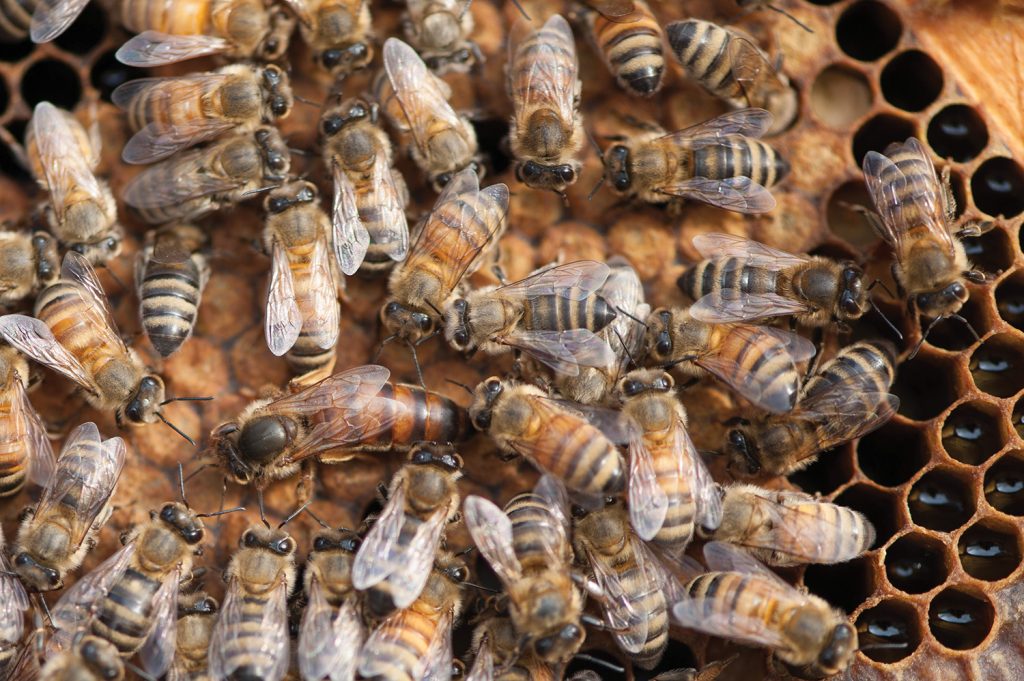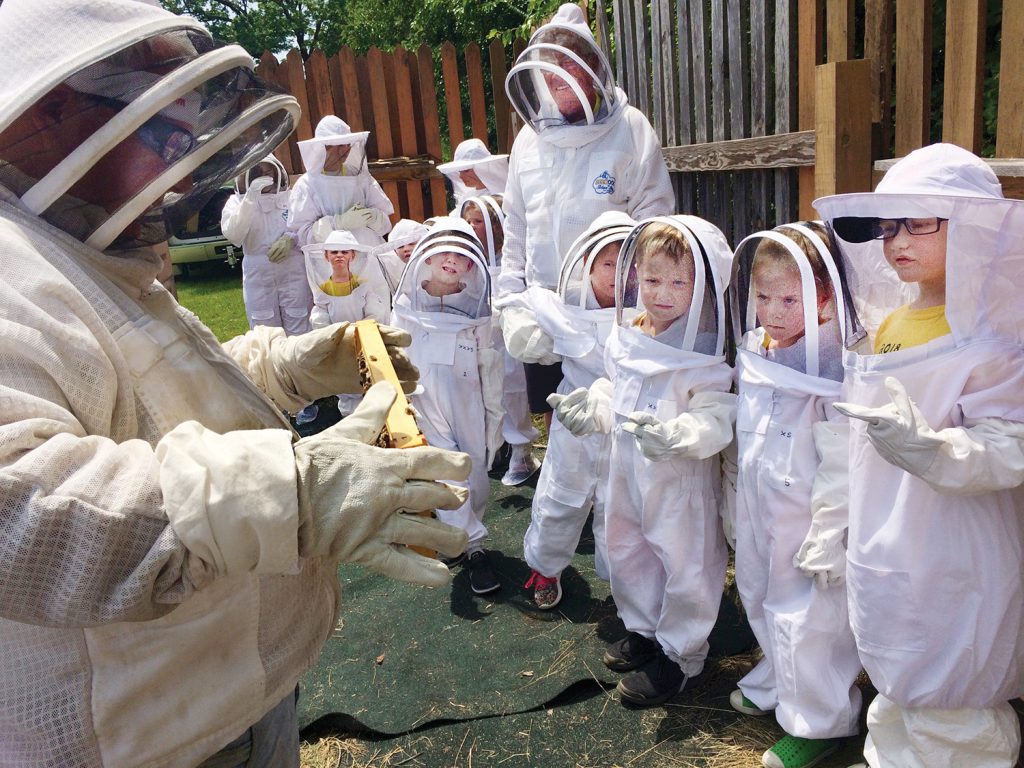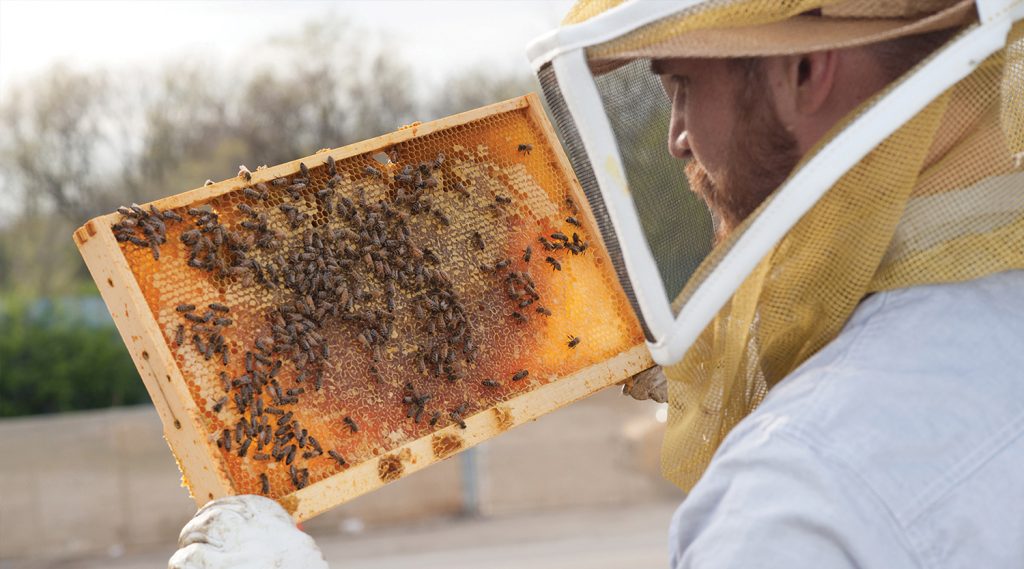
By Richard G. Biever
Between a drought and a lack of pollinators, the Community Share Gardens at Lebanon’s St. Peter’s Episcopal Church had little harvest to share in 2013. But help soon came from above — on the wings of … not a snow white dove … but honeybees.
From the church’s small but active congregation (weekly attendance is 30-some adults and children), two parishioners in particular, Chuck and Sandy Dailey, looked into what could improve the then 2-year-old garden ministry. The husband and wife team of now-retired Rolls-Royce engineers spent 2014 researching options, including beekeeping. By the spring of 2015, the St. Peter’s Apiary ministry was born. Chuck Dailey, now the ministry’s senior and a certified master beekeeper, has overseen up to nine hives on the church’s 8-acre grounds.
“Once we got the bees, our gardens became so much more,” Dailey said. “The harvest is so much better.”
But he noted honeybees don’t pollinate everything. By making their gardens safe for their honeybees — by practicing natural pest control methods and no longer spraying pesticides — it also brought back native pollinators like bumblebees and butterflies. “The native pollinators have really been bountiful because of our honeybees.”
The cornucopia the church began producing on half-acre plots and raised beds allowed the church to share its wealth of produce with the larger Boone County community, and beyond. Produce went to the food pantry run by St. Joseph’s, the Catholic church in Lebanon. Produce went to the Shalom House, a Saturday soup kitchen in town for seniors. And through beekeeping, St. Peter’s also connected with the Indiana Black Farmers Co-op.
Members of the cooperative grow gardens where they can in Indianapolis for those living in Indy’s food deserts where fresh healthy produce is harder to come by. Four groups from the co-op accepted an offer from St. Peter’s in 2020 to come north to Boone County to farm a half-acre plot the church provided. They then take the produce they grow there back to the markets in Indy.
“We’ve been really trying to expand our ‘Care of Creation’ ministry,” Dailey, 63, noted. “That is taking watch over what we’ve been given and being good stewards of the earth and everything that we have.”

Plight of the humble bees
Honeybees play essential roles in pollinating plants that humans and animals rely on for food. Declines in bee populations — including 20% of honeybee colonies per year in Indiana — threaten that food supply. Insecticide exposure, loss of flowering plants and nesting habitats, disease and parasites like varroa mites, and poor hive maintenance are all factors in the decline.
The national media has been abuzz with the plight of honeybees on and off for some 16 years. Dubbed “Colony Collapse Disorder” in 2006, the syndrome includes widespread honeybee deaths and the mysterious abandonment of hives by worker bees. Since then, much research has been directed at honeybees that help pollinate three quarters of the grown food we consume.
Overall, the number of honeybees kept in the United States has been declining since 1950. The Department of Agriculture said there were some 5.6 million honey-producing colonies then. Today, there are around 2.8 million. In Indiana, it’s estimated there are currently over 6,000 honey-producing colonies.
Most colonies will have around 60,000 bees which include the workers we most often see gathering the nectar, the male drones that mate with the queen, and the one queen who lays the eggs.
While culturally honeybees appear everywhere symbolizing natural goodness — from breakfast cereals to perfume to even alcohol (mead) — most people who slather golden honey across their breakfast biscuit or drop a dollop in their midday tea may not realize that honeybees are not native to North America. They are imports from Europe. The first colonists brought domesticated honeybees with them in the early 1600s for the natural sugar and the wax they provide.
The plight of the honeybee is real, but honeybees are hardly at risk of extinction. “They’re not a native species. So, they’ll never be an ‘endangered species’ in the United States,” said Kathleen Prough, chief apiary inspector with the Indiana Department of Natural Resources. “In Europe they can be but not here.”
In fact, more honeybees are on the planet today than at any time in history noted Alison McAfee, a honeybee researcher at North Carolina State University, writing in Scientific American. “For some reason, maybe because they are small, honeybees are not generally viewed as the massively distributed livestock animal that they are.”
Scientists, meanwhile, know little about the population status of most indigenous bees. Data from the International Union for Conservation of Nature indicates that many species are declining. Of particular concern: bumblebees. According to a 2015 analysis, 28% of North America’s 47 bumblebee species “face some level of extinction risk.”
They don’t get the media attention, but native pollinators — bumblebees, butterflies, hummingbirds — also pollinate plants that grow into the fruits and vegetables we eat. And some of the same issues affecting honeybees, especially pesticides, is affecting native pollinators. Many, like bumblebees, nest in the ground. Any pesticide on the ground can kill them.
“The biggest thing I tell people,” Prough said, “is if you plant flowers, the more native flowers you plant the better because they’ll attract native bees. And the honeybees will show up, as well.”
She also noted a large variety of native flowering bushes and trees that attract both honeybees and native pollinators.
For folks interested in becoming a beekeeper, Prough, 60, who is retiring this month from the DNR, suggests connecting with other beekeepers at their local meetings. “Talk to the beekeepers, go out with a beekeeper into their hives,” she said. “You have got to get used to bees flying around you. That freaks some people out even with a hat and veil.”
Healing power of bees
“The Keeper of the Bees” was the last work of famed Hoosier writer and naturalist Gene Stratton-Porter. Published originally as a magazine series shortly after her December 1924 death in a vehicle accident, the story was pollinated with her common theme of nature’s power. The piece spoke of reconciliation and healing for a wounded World War I veteran, an aging ailing beekeeper and a precocious child who come together through beekeeping.
Stratton-Porter seemed to foreshadow how beekeeping would come to be used to heal the afflicted. Veterans suffering PTSD, people with all kinds of physical and mental conditions find relief in bees. “They’re getting veterans into beekeeping because once you get in the hive, you just calm right down,” Prough explained. “You don’t want to be super hyper when you’re in the hive because the bees will know. You just calm down and just go slow and watch the bees.”
Ross Harding, 36, an Indianapolis-area beekeeper who makes his living keeping bees and selling the honey, noted humans and honeybees have been working together since the days of the Old Testament. “It’s a special relationship we’ve had for thousands of years, a long, long time. So, there’s all this folklore about people talking to bees, and how statistically beekeepers live longer …. It’s weird … it’s like that all across the world,” he said.
The ancient Greeks spoke of a special healing power in bees. And Harding noted “apitherapy” — that uses honey, pollen, bee secretions like “royal jelly,” and bee venom — is a thriving alternative medicine for many people in the U.S. Apitherapy is considered a traditional medicine in some parts of Europe and Asia.

Stewards of the Hives and the earth
It’s apropos that the apiary at St. Peter’s has become a ministry. St. Peter’s likes to note that most all churches offer coffee and doughnuts. But what other churches can offer coffee, doughnuts, and honey — especially honey that’s harvested on the church grounds?
Dailey noted that while honey is a beneficial byproduct, “Our main focus is teaching beekeeping.”
Last year, the ministry welcomed over 200 individuals, adults and children, who visited its hives to learn about the importance of pollinators. “We suit them up and take them in,” he said.
The church offers regular tours of the apiary twice a month. But if someone just stops by the church, Dailey said he and Sandy, who live nearby, are there about every day tending the hives or working in the gardens.
Dailey is also the education chair for The Beekeepers of Indiana. With local groups all around the state, the association brings beekeepers and those interested in beekeeping together to share information and insights. Dailey regularly gives talks across the state on beekeeping, including at the Indiana State Fair.
In the meantime, St. Peter’s developed another new ministry — “The Harvest House Community Center” — led by Sandy Dailey, a certified master gardener.
In an 800-square-foot teaching kitchen beside the church, the Daileys and a member of the Boone County Master Gardeners lead young people from the community through activities based on the Junior Master Gardeners curriculum. They teach the basics of gardening, the need for pollinators, and basic canning and food preparation techniques. The food grown by the youth at the church is either used by the youth themselves or donated to local food pantries.
“And so we’re trying to be good stewards, we try to be good teachers,” said Dailey.
And the church tries to be good neighbors, too. A bottle of honey is given every year to those who live alongside the church. “A lot of them grow fruit trees and different vegetables and things,” Dailey said. “That’s just more food sources our bees have.”
Was it just honeybees that turned St. Peter’s gardens around after that one rough harvest in 2013?
“No,” Dailey said. “It was a combination of honeybees and being very conscientious about what we do. Our realization that ‘hey, stop putting stuff on plants that kills pollinators’ has really brought our native pollinators back … back here, anyway. Bumblebees are huge here. They’re probably one of the hardest working pollinators.”
The Care of Creation ministry uses pollinators as a teaching tool to youngsters about the fragile balance in the greater circle of life. And Dailey said the humble honeybee and other pollinators highlight humankind’s role.
“We’re placed here to leave the earth better than we found it,” he said. “I have my ‘Masters Certification’ in beekeeping, but we’re placed here as stewards, not as masters. And not just honeybees, but native bees. They’re all important to us because our food source really depends on these guys.”
For more information about beekeeping, visit The Beekeepers of Indiana website: indianabeekeeper.com.
For more information about St. Peter’s Apiary Ministry and the other “Care of Creation” ministries at the Boone County church, visit churchthatgrows.org/.
RICHARD G. BIEVER is senior editor of Indiana Connection.
Your perfect lawn could be killing pollinators
Once upon a time, running barefoot through the yard meant treading carefully for fear of stepping on a bee making its way from one flowering white clover to the next and getting stung.
And there was a time kids put dandelion and clover flowers into old jelly or peanut butter jars and then caught honeybees. They’d watch the bees up close and hear them buzz around next to their ear for a bit before opening the lid and letting them fly away.
Throughout much of suburbia and even down country lanes, those are cherished memories younger generations never experienced. That’s because at some time between “once upon” and now, Americans started spending $75 billion a year for the perfect lawn. But in getting rid of clover and dandelions, we also rid our yards of honeybees and native pollinators.
While those flowering “weeds” may be unsightly to you, it’s important to remember they’re food to bees and other pollinators, said Doug Richmond, a professor of turfgrass entomology and applied ecology for Purdue’s College of Agriculture. He joined other researchers studying the impact lawn care practices have on pollinators several years ago. These researchers created a pollinator-friendly guide for lawn care that includes:
- Wait until May or June to apply pesticides if you need to use them at all. Early-season pollinators and colonies of bees are still recovering from winter stress in March and April.
- Use granular formulations of insecticides, which fall to the ground and avoid direct contamination of flowering portions of blooming plants.
- If you must spray, mow first to remove the flowers and the presence of pollinators.
- Establish plots of diverse, pollinator-friendly native plants that bloom from early spring to fall. Check with your local Master Gardeners for ideas on what to plant.



